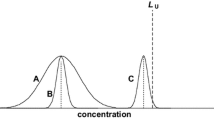Abstract
Analytical chemistry is a scientific discipline based on the search of qualitative and quantitative information embodied in unknown samples which are representative of targeted systems. A. Lavoisier measured masses, S. Arrhenius discovered ions, namely hydrogen ions, S. Sørensen introduced pH and the chemical community has been dealing abundantly with them, first in the frame of classical analysis and later by means of instrumental methods of analysis responsible for large amount of data. Although statistical treatment of measurement results became part of the procedures, it took a few decades of thinking and globalization of the economy to realize that more was needed for the sake of evidence of quality; and this was found in the bases of the science of measurement and on the metrological approach. At the dawn of the twenty-first century, the most measured chemical parameter, pH, set the example of such hierarchical targeting of measurement results fit for a certain purpose, which is worth noticing particularly because 100 years have elapsed since its first definition and initial recommendation of the measurement procedure.
Similar content being viewed by others
References
Arrhenius SA (1884) “Recherches sur la conductibilité galvanique des électrolytes” (Investigations on the galvanic conductivity of electrolytes). PhD Thesis, University of Uppsala
Sørensen SPL (1907) Enzymstudien I: Über die quantitative Messung proteolytischer Spaltungen, Die Formoltitrierung”. Biochem Zeit 7:45–101
Sørensen SPL (1909) Enzymstudien. II: Mitteilung. Über die Messung und die Bedeutung der Wasserstoffionenkoncentration bei enzymatischen Prozessen. Biochemische Zeitschrift 21:131–304
Oman SF, Camões MF, Powell KiptonJ, Rajagopalan R, Spitzer P (2007) Guidelines for potentiometric measurements in suspensions Part A. The suspension effect. Pure Appl Chem 79:67–79
Oman SF, Camões MF, Powell KiptonJ, Rajagopalan R, Spitzer P (2007) Guidelines for potentiometric measurements in suspensions Part B. Guidelines for practical pH measurements in soil suspensions. Pure Appl Chem 79:81–86
King EJ (1962) Qualitative analysis and electrolytic solutions. Oliver & Boyd Ltd., Edinburgh
Voggel A (1972) A textbook of quantitative inorganic analysis, 3rd edn. Longman, London
Buck RP, Rondinini S, Covington AK, Baucke FGK, Brett CMA, Camões MF, Milton MJT, Mussini T, Naumann R, Pratt KW, Spitzer P, Wilson GS (2002) The measurement of ph-definition, standards and procedures. Pure Appl Chem 74:2105–2136
Covington AK, Bates RG, Durst RA (1985) Definition of pH scales, standard reference values, measurement of pH and related terminology (Recommendations 1984). Pure Appl Chem 57:531–542
de Bièvre P. “Metrological traceability of measurement results in chemistry” http://www.iupac.org/projects/2001/2001-010-3-500.html
Acknowledgment
The author likes to thank Paul de Bièvre for interesting discussions.
Author information
Authors and Affiliations
Corresponding author
Rights and permissions
About this article
Cite this article
Camões, M.F. The quality of pH measurements 100 years after its definition. Accred Qual Assur 14, 521–523 (2009). https://doi.org/10.1007/s00769-009-0573-0
Received:
Accepted:
Published:
Issue Date:
DOI: https://doi.org/10.1007/s00769-009-0573-0




